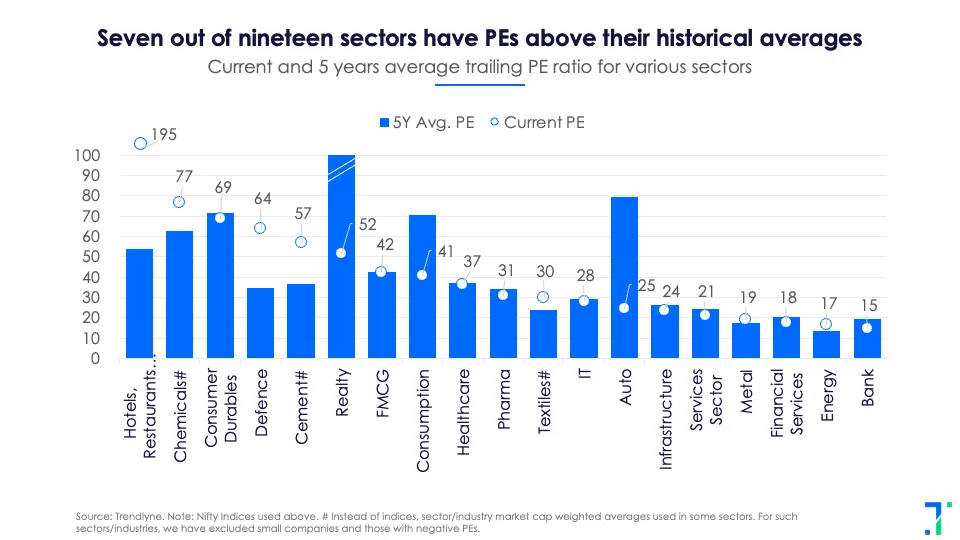
1. Tata Consumer Products:
Motilal Oswal reiterates its ‘Buy’ rating on this tea & coffee company with a target price of Rs 1,360, a 26.9% upside. Analysts Sumant Kumar, Meet Jain, and others highlight the company’s focus on growing its new businesses while maintaining core operations strength. Tata Consumer’s market share rose by 30 bps in FY25, helped by growth in the salt business. Its tea segment now holds a 20% market share, boosted by new product launches and strategic pricing.
Tata Consumer has rapidly expanded its direct reach to around 20 lakh outlets by FY25, with total distribution rising to about 44 lakh outlets—this is more than double the FY21 level. The company introduced split salesman routes (smaller areas assigned to each salesperson) across metros and towns with populations over 5 lakh to improve execution and coverage in large cities.
Kumar and Jain highlighted that the company is unlocking value through acquisitions. Its recent buys, Capital Foods and Organic India, reported strong growth of 19% in FY25, with combined revenue reaching Rs 1,170 crore and a healthy gross margin of 49%.
Analysts expect Tata Consumer’s revenue to grow by 8% and net profit by 20% over FY26–27. This growth is expected to be driven by newer businesses like Tata Sampann, Tata Soulfull, and ready-to-eat products, along with a focus on core brands and an expanding distribution network.
2. Insecticides (India):
Axis Direct initiates coverage on this agrochemical company with a ‘Buy’ rating and a target price of Rs 955, a 4.9% upside. Analysts Sani Vishe and Shivani More note that the company’s focus on premium products is driving both revenue and profitability. Its shift toward high-margin brands such as Maharatna and Focus Maharatna lifted the EBITDA margin by 281 bps to 11.1% in FY25.
The management aims to achieve double-digit revenue growth in FY26, driven by premium products, new launches, and higher rural demand. Analysts expect the company’s diversification into higher-margin products, supported by steady demand from the rabi season and an early start for kharif, to drive strong demand for its products.
In FY25, the company launched 12 new products and plans to launch six more in FY26. With a strong pipeline of launches and healthy rural demand, the analysts expect robust revenue growth and margin expansion in the near term. They estimate revenue and net profit to grow by 9% and 14%, respectively, over FY26–27.
3. AU Small Finance Bank:
Sharekhan maintains a ‘Buy’ rating on this bank with an upgraded target price of Rs 900, a 16.4% upside. The management expects net interest margins (NIMs) to remain under pressure in the near term due to lower repo rates, since 30% of its loan book is on floating rates. The bank cut its savings account rates by 25 bps each in April and June 2025 to manage costs, with the peak rate now at 6.75%.
AU SFB expects profitability to improve from H2FY26, supported by a likely cut in policy rates and falling credit costs (loan repayment losses), particularly in the unsecured segment. The management believes this should help ease margin pressures. Additionally, lower non-performing assets (NPAs), along with a majority fixed-rate loan book (~70%), are expected to support margins, though with a time lag.
Analysts expect the bank’s return on assets (RoA) to improve by 20–30 bps over FY26–27, from 1.5% in FY25, driven by lower loan losses and slightly better NIMs.
4. Tata Power Company:
Geojit BNP Paribas maintains a ‘Buy’ rating on this electric utility company with a target price of Rs 468, a 18.2% upside. In FY25, the company’s revenue rose 6.5% to Rs 65,478 crore, driven by strong growth in renewables and the distribution segment. Net profit grew 7.4% during the year.
The management aims to increase net profit 2.5 times by FY30 compared to FY24. The company has planned a capital expenditure of Rs 1.5 lakh crore by FY30, with 60% allocated to renewables and the rest to transmission and distribution, and pumped storage businesses. Praveer Sinha, CEO and MD, said, “For FY26, we have planned a capex of Rs 25,000 crore, with half of it allocated to renewables. In FY25, we added 2.3 GW (gigawatt) capacity and aim to add 2.5 - 2.7 GW this year.”
Analysts expect Tata Power’s investments in renewable and power transmission businesses to play a crucial role in long-term earnings growth. They estimate revenue to grow by 12% over FY26–27.
5. Shree Cements:
ICICI Securities maintains a ‘Buy’ rating on this cement company with a target price of Rs 35,330, a 19.2% upside. But in FY25, the company’s revenue declined by 5.9% to Rs 19,872 crore due to weak cement prices. Net profit dropped 53.1% due to higher raw material costs and logistics expenses.
Analysts Navin Sahadeo and Amit Gupta note the company’s focus on price hikes over volume growth. The price gap with peers in North India has narrowed to Rs 20–25 per bag, down from Rs 30–35. They believe this will support better realisations and margin improvement.
For FY26, the management targets 2–3% volume growth and expects EBITDA per tonne to remain at Rs 1,400, up from the FY25 average of Rs 1,070. They aim to increase their selling price per tonne by 6%. Analysts believe a price rise will help cover the impact of slow volume growth, and expect revenue growth of 9% in FY26.
Shree Cements plans to commission two 3 million tonnes per annum (MTPA) clinker units (partially processed cement units) in Karnataka and Rajasthan in FY26. It also aims to expand total cement capacity to 80 MTPA by FY30 from the current 62.8 MTPA.
Note: These recommendations are from various analysts and are not recommendations by Trendlyne.
(You can find all analyst picks here)















